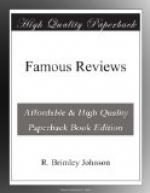Let it not be imagined, from any thing we have now said, that we think meanly of Mr. Maturin’s genius and abilities. It is precisely because we hold both in respect that we are sincerely anxious to point out their misapplication; and we have extended our observations to a greater length than we contemplated, partly because we fear that his strong though unregulated imagination, and unlimited command of glowing language, may inflict upon us a herd of imitators who, “possessing the contortions of the Sybil without her inspiration,” will deluge us with dull, turgid, and disgusting enormities;—and partly because we are not without hopes that our animadversions, offered in a spirit of sincerity, may induce the Author himself to abandon this new Apotheosis of the old Raw-head-and-bloody-bones, and assume a station in literature more consonant to his high endowments, and to that sacred profession to which, we understand, he does honour by the virtues of his private life.
THE QUARTERLY REVIEW
If Macaulay represents a new Edinburgh from the days of Jeffrey, Brougham, and Sydney Smith, the variety of criticism embraced by the Quarterly is even more startling. There was more malice, and far coarser personalities in the early days, and almost continuously while Gifford, Croker, and Lockhart held the reins: it is—almost certainly— among these three that the responsibility for our “anonymous” group of onslaughts may be distributed. The two earliest appreciations of Jane Austen (from Scott and Whately) offer an interlude—actually in the same period—which positively startles us by the honesty of its attempt at fair criticism and the entire freedom from personality.
Gladstone’s interesting recognition of Tennyson, and the “Church in Arms” against Darwin (so ably pleaded by Wilberforce), belong to yet another school of criticism which comes much nearer to our day, though retaining the solemnity, the prolixity, and the ex cathedra assumption of authority with which all the Reviews began their career; and is singularly cautious in its independence.
WILLIAM GIFFORD
(1757-1826)
Gifford was the editor of the Quarterly from its foundation in February, 1809, until September, 1824, and undoubtedly established its reputation for scurrility. It is probable that more reviews were written, or directly inspired, by him than have been actually traced to his pen; and, in any case, as Leigh Hunt puts it, he made it his business to
See
that others
Misdeem and miscontrue, like miscreant
brothers;
Misquote, and misplace, and mislead, and
misstate,
Misapply, misinterpret, misreckon, misdate,
Missinform, misconjecture, misargue, in
short
Miss all that is good, that ye miss not
the court.
Gifford was hated even more than his associates; not only, we fear, for his venal sycophancy, but because he had been apprenticed to a shoemaker and never concealed the lowness of his origin. Moreover, “the little man, dumpled up together and so ill-made as to seem almost deformed,” received from Fortune—




